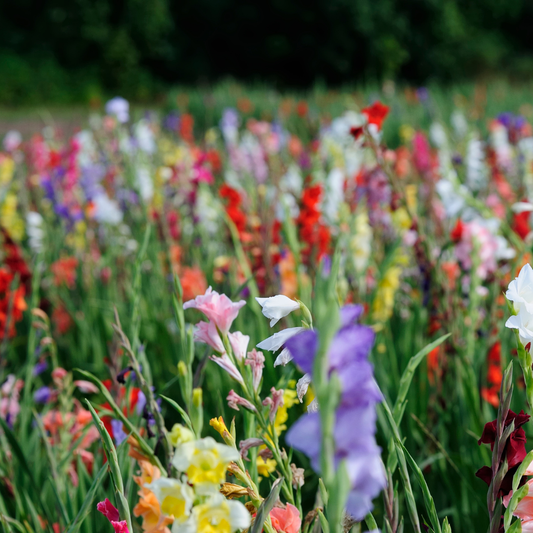
When to Plant Grasses?
Share
When to plant grasses: the best times for your ornamental grasses
Why plant ornamental grasses in your garden?
Grasses are the garden's secret weapons: they add texture, movement, and elegance. Whether you're aiming for a wild prairie look or prefer to create neat borders, ornamental grasses fit into almost any garden design. Moreover, they're often low-maintenance, drought-resistant, and sometimes even remain beautiful in winter.
When to plant grasses in open ground?
Ornamental grasses are best planted in spring or early autumn. Choose a dry but cloudy day in March, April, or September so the plants have time to develop roots before extreme heat or frost hits. In spring, grasses have plenty of time to grow throughout the summer and establish themselves firmly.
Planting in the fall is also fine, but ideally, do so before the end of October. Choose a day without rain, but also without full sun. The soil should still be warm enough to allow root growth, but wet conditions can cause young roots to rot. Ensure well-draining soil, possibly with some perlite or pumice mixed in to aid drainage.
What about plants in a greenhouse?
If you have a conservatory or greenhouse, the situation is slightly different. While you can technically plant grasses in a greenhouse year-round, spring and autumn are also preferred. In winter, the light is often too weak, and young plants can't develop properly. In summer, it's too hot if you don't provide ventilation or shade cloth.
Ideally, choose a mild spring day, just after the last frost. The daytime temperature in the greenhouse should be around 18 to 22 degrees Celsius for a smooth start. Some grasses that prefer tropical conditions, such as pampas grass, thrive in a warm greenhouse environment. Want to plant pampas grass ? Be sure to read our separate blog post about it.
Different types of grasses and their preferences
Evergreen vs. deciduous grasses
Not all ornamental grasses are the same. Evergreen varieties like Carex retain their color and shape year-round. These are best planted in spring, as they need to branch out well immediately before they can withstand a cold winter.
Deciduous grasses like Miscanthus can be planted a little later, even into the fall. They will die back in winter but will sprout again in spring. When planting in the fall, be sure to use plenty of mulch to protect young plants from frost.
Grasses in containers or flower pots
Want ornamental grasses for your patio or balcony? Then it's a good idea to plant them in a large pot with drainage holes. Use an airy potting soil with a mix of coconut husk and perlite to prevent the roots from getting too wet. You can pot them year-round, although the grass grows faster if you plant them in March or April.
Potted grasses are also ideal for small spaces or student digs. In our student deal, you'll find low-maintenance, long-lasting plants that are perfect for small spaces.
Tips for planting
Regardless of the variety, it's important to plant each grass at the correct depth: the same depth as it was in its growing pot. Firmly press the soil around the root ball and water thoroughly. This helps the plant quickly connect with the surrounding soil.
Consider applying a layer of mulch around the grass right away. This will retain moisture and prevent weeds. This is a helpful extra step, especially on dry summer days or when planting in full sun.
Combine with other plants
Of course, you don't have to keep grasses all to yourself. They blend perfectly with large-leaved houseplants like Monstera deliciosa or robust yuccas for a more architectural effect. Grasses add structure to your outdoor space, while houseplants create a cozy urban jungle indoors.
Those who enjoy experimenting can even combine ornamental grasses with other garden bloomers, such as dahlias , lavender, or even herbs like mint .
Post-planting maintenance
Watering and fertilizing grasses
After planting, it's important to give your ornamental grass plenty of water for the first few weeks. Regular watering is especially crucial during dry spells. But be careful: the grass shouldn't be constantly left with wet feet. Consider using hydroponic clay pebbles or vermiculite for better drainage, especially when planting in heavy clay soil.
Fertilizer is usually only needed from the second growing season onward. Use a light organic fertilizer in spring to stimulate growth. More is really not necessary.
To prune or not to prune?
Deciduous grasses are best pruned back in spring, when new growth is already visible. This protects the plant from the winter cold. Evergreen varieties usually don't need pruning unless you see dead or damaged leaves.
Do you want to give your lawn more structure or maintain a bit of a wilder look? In either case, you can experiment with pruning heights and timing to find the right look for your garden.
Ready to plant?
Grasses are incredibly versatile and offer plenty of room for experimentation. Whether you're planting them in a border or in pots on your patio, the key is to plant them at the right time. Spring and early autumn are your partners in crime. Want to wait a little longer? No problem. In a conservatory or greenhouse, you have a little more flexibility with timing.
Want to combine grasses with easy-to-grow houseplants? Then be sure to check out our selection of easy-to-grow houseplants for beginners . Consider the low-maintenance ZZ plant or the tropical Aglaonema Green Lady , which will instantly give your garden or room an exotic jungle feel.
So, ready to fill your garden with waving plumes of grass? Now you know exactly when to break ground!


